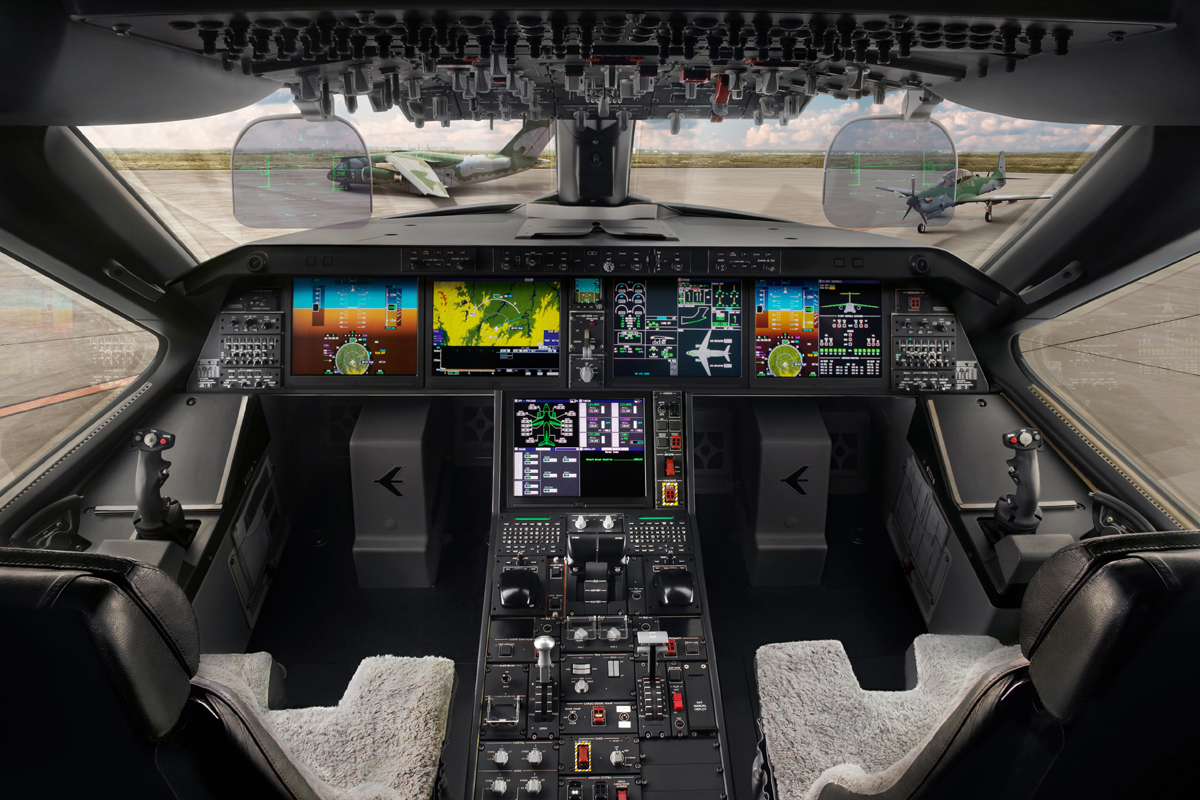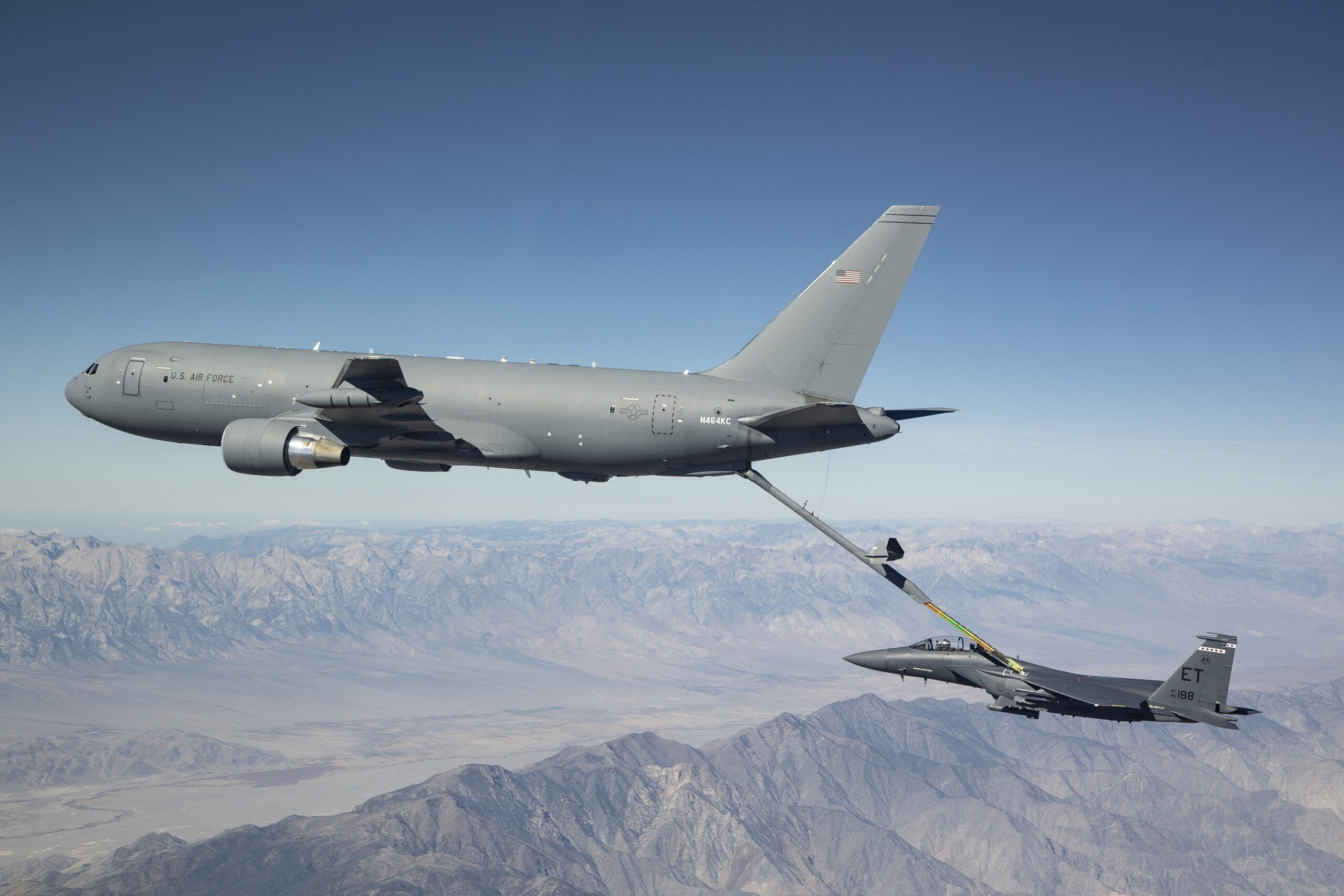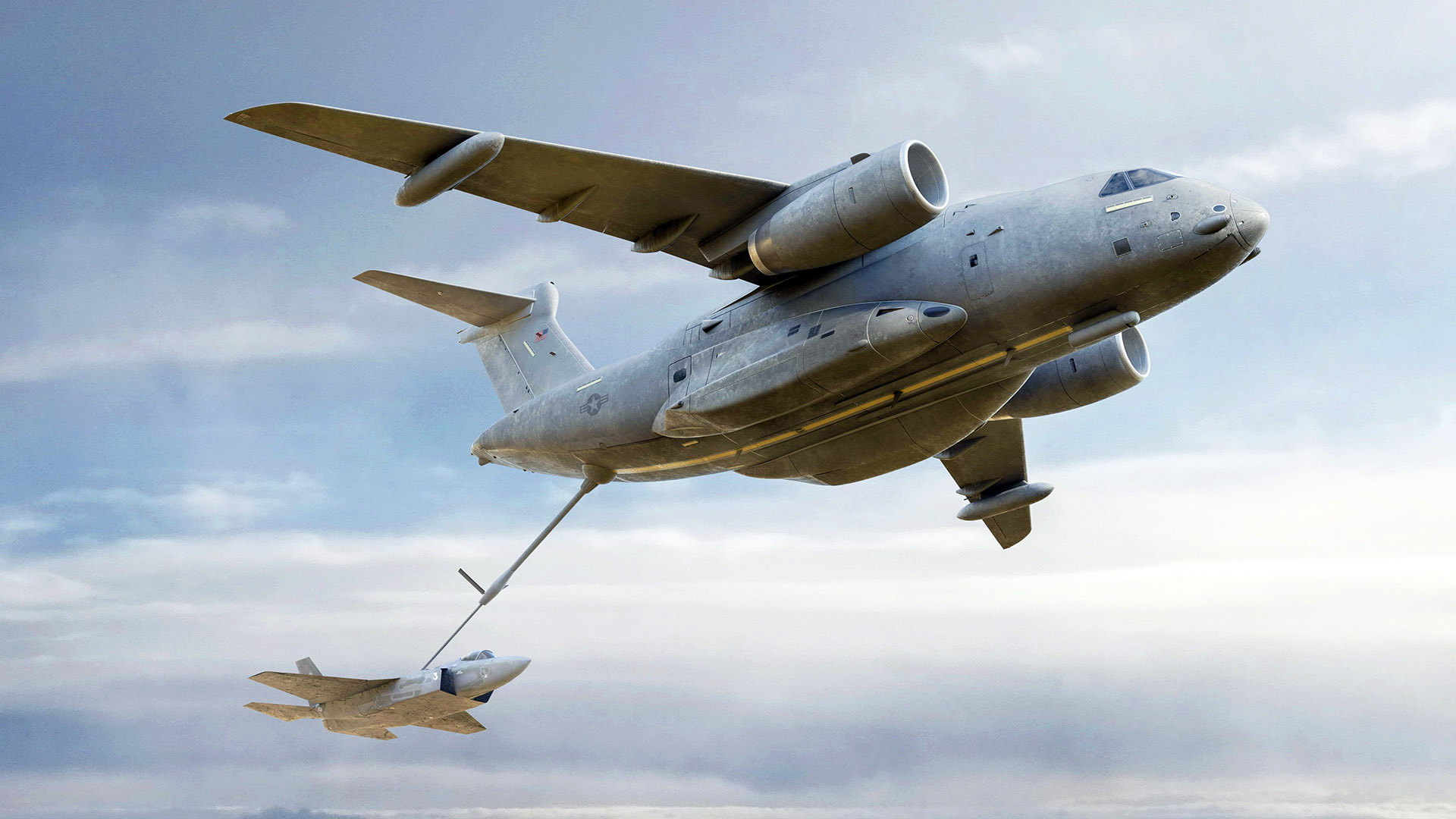L3Harris and Brazil-based Embraer have announced that they will be partnering to develop an ‘agile tanker’ equipped with a boom refueling system based on the latter’s multi-role KC-390 tanker-transport, which would also thereby introduce the type to the U.S. market. By using this particular airframe, paired with a refueling boom that is more typically found on larger tankers, the companies hope to achieve a tactical tanking solution intended to fly fuel closer to the front lines and out of austere bases to better address logistical complications brought by a peer state competitor, like China. Simply put, there is nothing like this in existence today and it very well could be a logical choice as the Air Force struggles with its existing tanker fleet’s tactical and capacity concerns.
The two companies first revealed the agreement yesterday ahead of the start of this year’s Air & Space Force Association Air, Space, & Cyber Conference, and said that L3Harris will take on the prime contractor role to ensure the tanker’s mission systems meet U.S. specifications. In statements released by both companies, it was also explained that the collaboration will aim to “expand” upon the preexisting capabilities of Embraer’s KC-390 Millennium. These enhancements are said to include “advanced boom operations and mission systems” intended to facilitate “agile basing and sustainment for operations in contested areas and resilient communications supporting [Joint All-Domain Command and Control] requirements.”


L3Harris said specifically that the new version of the KC-390 will build on the type’s existing ability to refuel aircraft with a variable speed drogue, receive fuel, carry cargo, and take off and land from short and improvised runways. The latter capability is a characteristic of the tanker that would especially serve the Air Force’s Agile Combat Employment (ACE) framework. ACE is described by the service as a methodology that would allow forces to rapidly deploy to and from disparate and austere locations in-theater without sacrificing combat capability, which can be difficult for a large tanker to achieve.
“U.S. Air Force strategic planners have stated Agile Combat Employment will require refueling platforms optimized to support a disaggregated approach to air dominance in contested logistics environments,” said Christopher E. Kubasik, chair and chief executive officer at L3Harris. “Collaborating with Embraer to develop and integrate new capabilities to the multi-mission KC-390 provides a cost-effective, fast-to-field solution that embodies our trusted disruptor approach.”
Embraer began work on what was then known as the C-390 in the mid-2000s, and the aircraft became the company’s largest and most complex platform in its portfolio. The KC-390 took its first flight in February 2015, was delivered to the Brazilian Air Force in 2019, and has served a variety of missions ranging from cargo transport to aerial refueling. As a transport aircraft, the KC-390 features a cargo bay equipped with an aft ramp and is capable of carrying up to 26 tons worth of materiel.
The Brazilian Air Force plans to buy 22 total KC-390s, and Portugal, the Netherlands, and Hungary have all ordered smaller numbers for their air forces, as well.
The KC-390 is powered by two International Aero Engines’ V2500-E5s and uses fly-by-wire flight controls and a modern ‘glass cockpit’ to help automate certain aspects of its operations and reduce pilot workload. The Collins Aerospace Pro Line Fusion avionics system that the aircraft uses is designed with an intuitive human-machine interface and synthetic vision capabilities to enhance situational awareness.

Pro Line Fusion is also engineered with an open architecture, which allows for the rapid integration of new technologies and software to better tailor the system to the needs of the end user, and will certainly come in handy as the KC-390 undergoes its reconfiguration for U.S. customers. In terms of performance specs, the KC-390 can fly at a maximum altitude of 36,000 feet, a speed of about 532 knots (maximum cruise is 470 knots), and boasts a max range of approximately 3,250 miles, which is markedly reduced for various missions and cargo configurations.
Even its landing gear is ideal for an ACE deployment, as its ruggedized double chamber shock absorbent system better enables the KC-390 to land on unkempt airfields. The aircraft’s combined traits have resulted in some calling it a ‘jet powered’ C-130, although this is a loose comparison at best.

When speaking to Breaking Defense, an L3Harris executive refrained from saying too much about the KC-390’s boom system, but did reveal that the company is working on several options that include the ability to operate it either remotely — like on the KC-46 — and directly — like in the KC-135 and KC-10.
Overall, a KC-390 would provide a significantly smaller footprint than that of a traditional boom-equipped tanker, allowing it to work out of tighter airfields. L3Harris says that the boom-equipped KC-390 itself will still be capable of receiving fuel in flight. However, the model at the Air & Space Force Association Conference shows that it will have a boom receptacle above the cockpit instead the standard type’s refueling probe. Paired with its own refueling boom and the ability to carry out ground refueling operations for other aircraft, the KC-390 will be able to provide ACE deployments with a critical fuel lifeline, not just in the air, but also on the ground, and do so at significantly extended ranges.
With its own aerial refueling capability, an Air Force KC-390 could fly out to refuel from a larger tanker, such as a KC-46, and then return that fuel to austere airfields to be used by combat aircraft. Currently, only the service’s special operations-configured M/HC-130s can do that and they do not have a boom of their own so they cannot also provide fuel to Air Force receptacle-equipped aircraft, which accounts for nearly all of the force’s fleet. Basically, the KC-390 could allow for true ‘hub and spoke’ tanker operations, including from austere areas, during a major conflict. This could be especially attractive for refueling tactical aircraft, like fighters and eventually drones, from forward locales. Once again, currently, the Air Force doesn’t have a solution for this problem, which could make the KC-390 very attractive.

There are also the multi-role capabilities this aircraft provides, being able to move cargo and personnel to far-flung locations at jet speeds. Once again, this would support a hub-and-spoke concept of operations across a vast theater like the Pacific.
Beyond that, it can carry secondary networking payloads, even while it is doing its aerial refueling mission, which would be critical to the forward fight. Even in the renderings, you can see it carrying a pod under its forward fuselage. It’s not entirely clear from the artwork what the purpose of the pod might be, but it could be for networking, as well as self-defense, such as an electronic warfare pod.
KC-390s have been seen carrying LITENING advanced targeting pods under the forward fuselage during testing, as can be seen in the video below. LITENING pods have been used on C-130s to help with airdrops and to aid in landing at remote airstrips, as you can read more about here.
All the aforementioned podded capabilities could be pushed forward via the combination of KC-390 and ACE.
As noted earlier, the ACE concept will become especially prevalent as the United States continues to keep a pulse on China and any corresponding developments in the Pacific. Considering the sheer size of the region, maintaining the flexibility to disperse aircraft and other assets in less condensed groups will not only ensure widespread U.S. presence, but also prevent adversaries like China from targeting and taking out large amounts of aircraft and other capabilities by attacking just a handful of installations. It also greatly complicates the enemy’s own defensive strategy.
ACE aside, though, L3Harris and Embraer seem hopeful that the KC-390 will also be beneficial in addressing more general tanker capacity issues that have been plaguing the U.S. Air Force. What Congress has since dubbed an “aerial refueling gap,” which was exacerbated been over worries about tanker capacity after the retirement of the KC-10 tanker fleet and several pitfalls in the newer KC-46 Pegasus’ design came to light. In addition to that, there is no direct replacement for the KC-10 yet in the works, but the Air Force does seem to be pushing ahead with its next-generation KC-Z tanker concept now that a formal analysis of alternatives is slated to begin in 2024.

Before L3Harris and Embraer announced their new plans for a boom-equipped KC-390, the Air Force had introduced a competition for a “bridge tanker” known as KC-Y to address the refueling gap in question. However, the service is expected to decide on whether or not it’s still worth pursuing in the next few months. This has led some to suspect that KC-390 will be in the running, but L3Harris told Breaking Defense that it doesn’t plan to offer the aircraft as a KC-Y contender, only as a complementary, agile addition to the Air Force’s tanker fleet. This does make sense, because while it can help address the overall capacity issue, which could be especially useful in freeing up the big tankers during peacetime training, a small boom-equipped tactical tanker goes farther by introducing a whole new capability set.
L3Harris plans to start work on its new Agile Tanker as soon as possible and projects that its first flight could take place as soon as 2025. There will be much to be proven, including the size of fuel loads that can be available for offload on a normal mission and how the miniaturized refueling boom will actually work. There are also major headwinds in terms of the Air Force being willing to take on a new type and the notoriously powerful array of special interests when it comes to tanker procurement. But as the United States gets more serious about threats in the Indo-Pacific, particularly from China, the flexibility that KC-390 may offer could be a bonafide game-changer.
Contact the author: Emma@thewarzone.com and tyler@thedrive.com
